Taylor Swift may or may not be “America’s Sweetheart,” as she is called by some, but she’s undeniably a huge cultural force and mega-purveyor of mainstream pop music. So why is she dabbling in the “furry” fringe subculture in her latest music video, “We Are Never Ever Getting Back Together”?
In case you can’t watch the video, here’s a still that shows Swift’s animal-costumed band helping her get over her breakup with Jake Gyllenhaal:
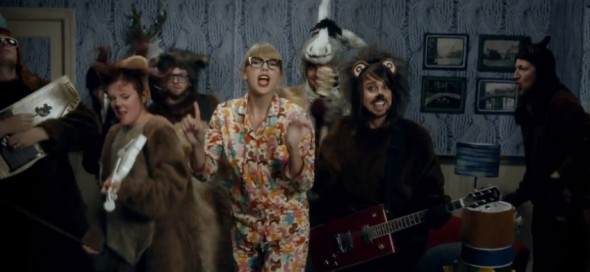
As if to prove that their presence wasn’t an accident, she trotted them out again at her performance at the MTV Video Music Awards. Here’s a still showing the furries in background:
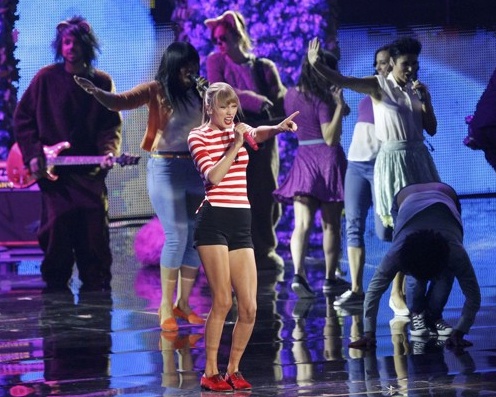
Taylor Swift may just be throwing some interesting visual imagery into her videos and live performance for the sake of novelty. But I think there’s more to this than throwaway weirdness. (This is OverthinkingIt.com, after all.) Let’s focus for a moment on one of the band members in particular, the one in the bear costume and a distinctive rectangular guitar:
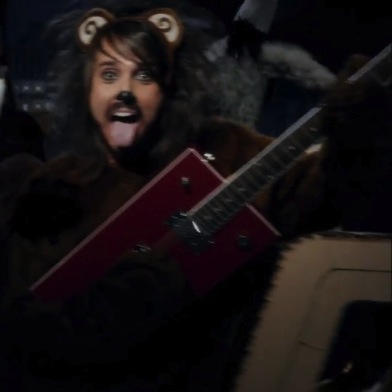
If this looks familiar to you, it’s probably because it’s the trademark guitar of blues legend Bo Diddley:
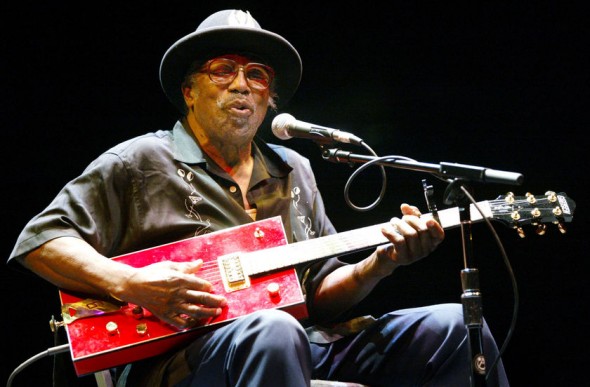
But that only covers half of the bear costume + oddly shaped musical instrument combination. Both can be found in The Country Bear Jamboree, a Disney attraction comprised of hillbilly animatronic bears:

And there’s even another example of an animatronic musical bear sporting a rectangular stringed instrument: the Rock-afire Explosion band from Showbiz Pizza (now a part of the Chuck-E-Cheese pizza chain):
While you collect the shattered pieces of your blown mind, let me remind you of what I said earlier: there’s more to this than throwaway weirdness. As we’ve pointed out many times in our Musical Talmud series, a lot of time, energy, and thought goes into a music video and its visual elements. If we can’t ignore small details like Vespas and vintage comic books, then we sure as hell can’t ignore the 800 pound Electric Country Bear in the room.
By now you’ve hopefully reassembled the shattered pieces of your blown mind and are now asking yourself, “So what does this all mean?” I’m glad you asked. We’re actually looking at a rich and revealing portrait of the Dualities of Taylor Swift, as represented by a bear costume and a rectangular guitar.
Now let’s unpack that a bit, shall we?
Swiftian Dualities

She wears sneakers AND high heels. At the same time.
Casual observers of Taylor Swift are probably familiar with her surface identity as “America’s Sweetheart,” a wholesome, fresh-faced musician who performs earnest, unoffensive music and doesn’t get into trouble. A sort of anti-Britney Spears, if you will. None of these ideas are inaccurate, but by themselves, they suggest that Swift neatly fits into a monolithic archetype, and they don’t do justice to the complexities of Swift’s identity.
She is both Northern and Southern. Swift was born in Pennsylvania and spent summers in Stone Harbor, NJ, but she moved to Hendersonville, TN (close to Nashville), at the age of 14.
She is both country and pop. Although she’s been repeatedly awarded by country music’s establishment, The Academy of Country Music, her music is by no means bound to the genre’s conventions, and she constantly faces criticism from fans for “going too pop.”
She is both graceful and awkward. Swift may seem like the model of a perfectly poised and composed singing princess, but she both intentionally and unintentionally gives an edge that flawless image. She plays both the cheerleader and the nerdy band geek in the video for “You Belong With Me.” Her repeated expressions of surprise when receiving awards has been lampooned on Saturday Night Live. She was described in a Grantland piece as “dorky” and “openly neurotic in a way you’d never see from a blonde country princess like Faith Hill or Carrie Underwood.”
Granted, most public figures are rife with internal contradictions and don’t fit the archetypes that we so readily pigeonhole them into. Taylor Swift isn’t unique in this regard. But it’s important to highlight these dualities, as they help us understand the bear suit and guitar combination.
So, about that bear suit and rectangular guitar. Let’s leave the (relatively) safe territory of Taylor Swift’s curly blond hair and figure out what’s going on with the Furries.
Furries and Pseudo-Furries
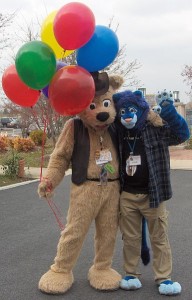 The subculture of Furries is too broad of a topic to adequately cover in this piece, but here’s a brief summary. Furries are, broadly speaking, fans of anthropomorphic fictional characters. This most notably takes the form of wearing furry animal costumes; hence the name. Occasionally, this takes the form of sexual attraction to anthropomorphic characters and characteristics, hence the marginalization and criticism of the subculture. To put it bluntly, they represent the bottom tiers of the “Geek Hierarchy.”
The subculture of Furries is too broad of a topic to adequately cover in this piece, but here’s a brief summary. Furries are, broadly speaking, fans of anthropomorphic fictional characters. This most notably takes the form of wearing furry animal costumes; hence the name. Occasionally, this takes the form of sexual attraction to anthropomorphic characters and characteristics, hence the marginalization and criticism of the subculture. To put it bluntly, they represent the bottom tiers of the “Geek Hierarchy.”
(Note: we’re not in the business of judging fringe subcultures here on OverthinkingIt.com, so none of this should be taken as offense to any Furries in the audience. And we should also note that the erotic Furries are a subculture within the subculture and are by no means representative of the larger movement.)
So how does this play out in the video? Not well, according to the Washington Post‘s reaction to the VMA live performance:
Why, oh why, were the members of Swift’s band dressed in animal mascot costumes during her performance? It edged uncomfortably close to the subculture of Furries, those folks who wear animal suits and take on “fursonas” It was a big moment for the mainstreaming of Furries, though — first “Ted,” now this.
Update: As commenters have rightly pointed out, the furries appeared in Swift’s music video. That doesn’t make them any less weird, though.
The commenters on the piece were quick to criticize the author of the above criticism, and rightfully so. The knee-jerk hating on Furries is certainly uncalled for, as is the casual dismissal of the whole conceit as “weird” and therefore not good or pleasing to a mainstream audience.
But let’s step back fur a moment. The animal costumes in the video are certainly evocative of Furries, but they stop short of going full Furry. Part of what turns people off from the idea of Furries is the creepy nature of cute-but-motionless animal head masks. It’s intentionally de-humanizing. Furries would call that a feature, not a bug: a means of enhancing the immersive, escapist nature of their activity. For everyone else, it’s a cause for alienation and discomfort.
The costume-wearers in Swift’s video are wearing animal ears and have painted-on animal facial features, but they are definitely not wearing full-facial masks:

We can still clearly see their human facial features. Complete alienation and discomfort are averted, but plenty of weirdness and whimsy still abound.
So, getting back to Dualities. Just as Swift is defined by her internal contradictions, so, too, are these pseudo-Furries:
They are both human and animal. They’re mostly covered in fur, and some of them have paws, but we still see their unmistakably human faces, not the ghoulish masks of the full-body Furry costumes.
They are weird enough to be outside of the mainstream and to puzzle a Washington Post blogger, but they are not so weird that they completely alienate most fans. This second point fits right in line with Swift’s conscious efforts to sprinkle edginess along with her squeaky-clean “America’s Sweetheart” image.
The pseudo-Furries by themselves would be a fine illustration of Swiftian Duality, and if it were just people in bear costumes, we could call it a day. But we’re just getting started. We still have that rectangular Bo Diddley guitar to contend with.
Bo Diddley and the Twang Machine
If you need a quick introduction to the music of Bo Diddley, here’s a video of Diddley playing his most famous song, “Who Do You Love,” with the Rolling Stones:
In this video, you can see his signature guitar, nicknamed the “Twang Machine.” We’ll get back to the guitar in a moment, but first, a brief biographical sketch of Diddley: like so many other blues legends of his era, Diddley was born in rural Mississippi and later moved to urban Chicago. An entire generation of African-American blues musicians are defined by this North-South duality, including Muddy Waters, B. B. King, and Howlin’ Wolf. Taylor Swift’s North-South journey may have been in the opposite direction (and far less difficult), but like the journey of the old bluesmen, it spans America’s most prominent cultural divide and probably helps broaden the appeal of her music across both sides of that divide.
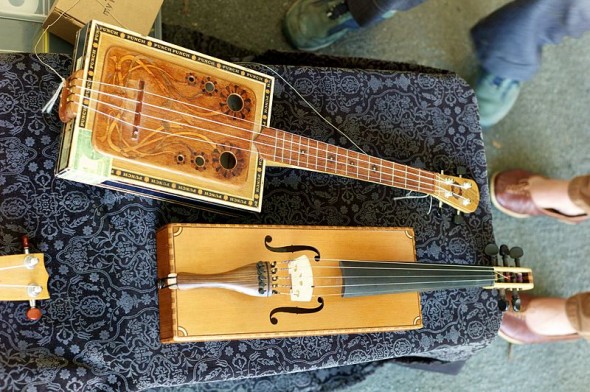
Diddley’s guitar may look similar to these crude instruments, but is actually a sophisticated, modern, fully solid-body electric guitar made by Gretsch. (Given its mid-20th century date of inception, the argument could even be made that the shape is evocative of modern art a la Kandinsky and Mondrian, but I’ll leave that interpretation to others.) In other words, with his guitar, Diddley is expressing the duality of his music and his image: old-timey, unsophisticated, Southern, and rural, while also amped-up, modern, Northern, and urban at the same time.
By now, the connection between Diddley’s guitar and Swift’s country-pop genre-straddling should be clear. The guitar is a potent symbol of negotiating internal contradictions and occupying two distinct cultural spaces at the same time, hence its appropriateness in a Taylor Swift music video.
So before we wrap things up, let’s recap where we are: the presence of the Furries represents Swift’s graceful-awkward duality. The presence of Bo Diddley’s guitar represents Swift’s North-South and pop-country dualities. So a Furry holding Bo Diddley’s guitar must be the apotheosis of Swiftian Duality, right?

Well, not exactly.
The Country Bear Jamboree
The problem with combining the bear-suited Furry and the Bo Diddley Guitar is that, in doing so, the bear-suited musician transcends Furry Culture and Bo Diddley to become something else entirely. You see, when bears play rectangular musical instruments, they are typically seen doing so as part of the Country Bear Jamboree:
This cultural oddity opened in the Magic Kingdom (part of the Disney theme park in Orlando) in 1971 and resulted from Walt Disney’s desire to create some sort of bear band. It’s still operating today, and even spawned a feature film in 2002:
(Side note: I’m bracketing from this analysis any further discussion of the aforementioned Rock-afire Explosion band, since it was born as a knock-off of the Country Bear Jamboree, but I will use this as an excuse to link to the bizarre collection of videos of the band covering modern pop songs. You’re welcome.)
How does this fit into the already crowded visual language of this music video? After considerable Overthought, I will admit that the reference to the Country Bears may be accidental or unintentional, since the idea of animatronic bears sort of overrides the idea of Furries. But if you’re still with me, then you know we’re in too deep to stop now. Bear with me as I continue: the Country Bears band and their cigar box instruments are a nod to Swift’s country music roots and the musical stylings of country that are not well represented in the sounds of the song itself. That’s less of a duality in itself as it is an expression of one part of the country-pop duality. Likewise with Swift’s years in Tennessee; the Country Bears represent just one part of her North-South duality.
So the Country Bears do fit into this analytical framework, though not as neatly as the Furries or Bo Diddley’s guitar. I’m a little disappointed by that, but the mere fact that this exercise gave me the excuse to reference the Country Bears (and the Rock-afire Explosion) more than makes up for that disappoint.
Conclusion
Taylor Swift may not be unique in the way that dualities and contradictions define her identity, but she is unique in how she expresses those dualities and reconciles their contradictions. Other artists choose the safer path and forsake one side of their dualism in favor of the other, but Taylor Swift takes the more difficult path and fuses them together in a new syncretic identity. She is Northern and Southern. She is Country and Pop. She is Graceful and Awkward.
She is America’s Postmodern Sweetheart.
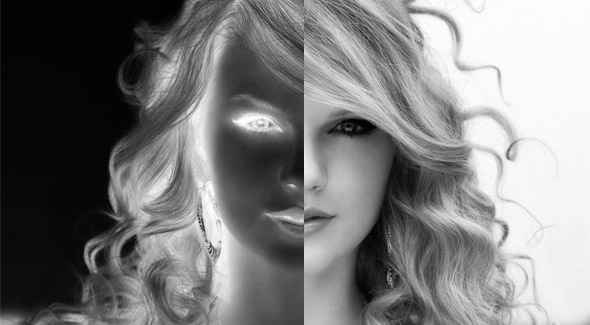
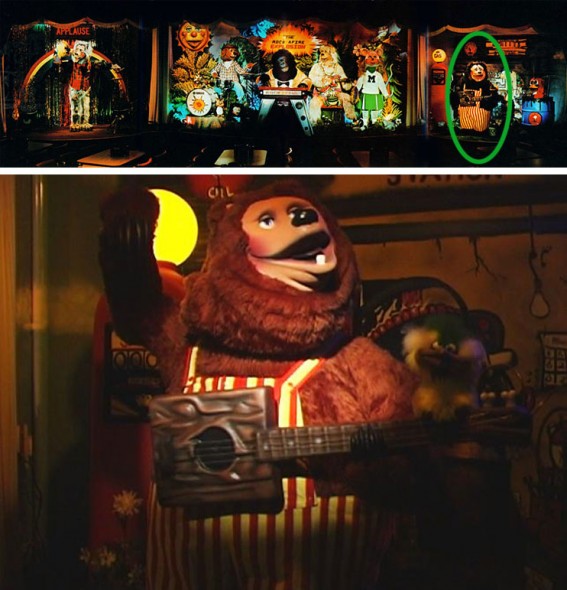
I can’t believe no one has called me out on the two awful, shameful puns that I used in this article. Absent any complaints, I take this as approval and license to continue to pun.
We noticed. The puns were just a nice icing on the cake.
Also interesting to point out is the way she sings the second line in the chorus, which eerily sounds like a pig call (as in “soo wee!”). This could generalize the theme of the song, from furries to animals.
I think the country bears jamboree does represent the duality of Taylor Swift. They are a country themed band, indicating her could try side, but are robotic figures which can easily be attributed to the industrial development of the north eastern United States. This combination of southern musical styling with northern industrialization paints a solid picture of how Swift was raised with northern ideals and inspired by southern culture. Just a connection that I picked up on while following this excellent logic.
Great article! Do you think there’s any connection here with the music video What Does The Fox Say? by Ylvis?
does any body really know who is that country bear?? his face is very familiar to me my mind is blowing but i cant remember how do i know that face :/